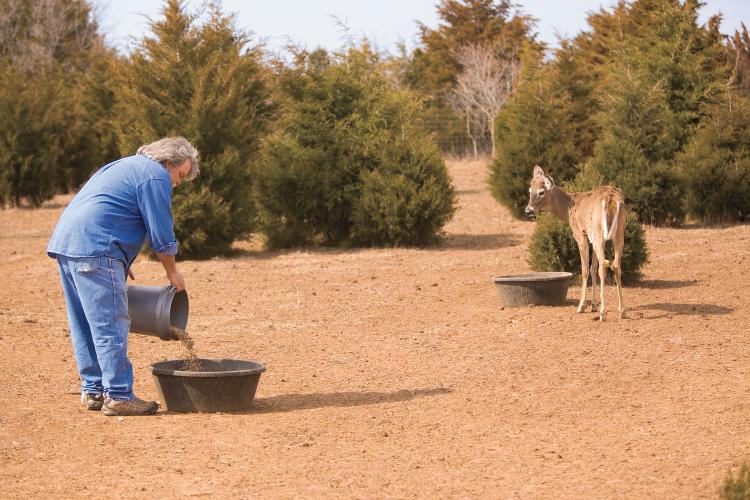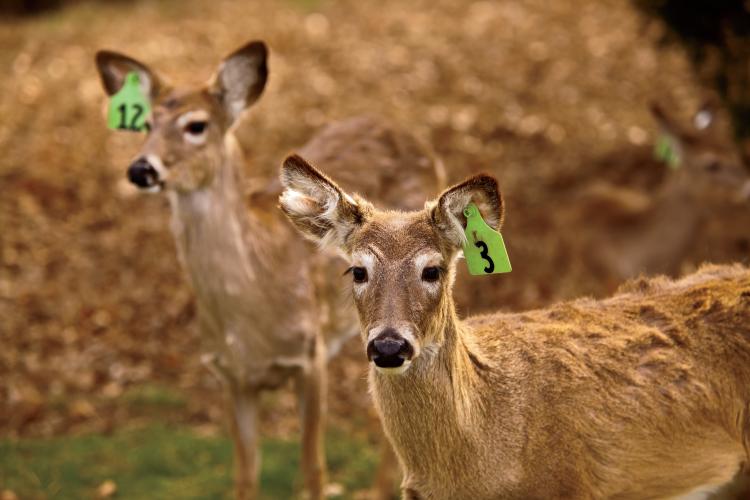Home > Oklahoma > Oklahoma Crops & Livestock > Deer Farms Produce Big Bucks for State
Deer Farms Produce Big Bucks for State

White-tailed deer are the most prized big game animal in the country, and several enterprising Oklahoma farmers have made a business of producing some of the highest-quality deer found anywhere.
Oklahoma has approximately 220 licensed deer farms, according to Dr. Justin Roach, staff veterinarian for the Oklahoma Department of Agriculture, Food and Forestry. He says approximately two-thirds are focused on the industry of breeding and selling white-tailed deer, while the rest raise deer as a hobby.

Farming For the Future
For farmers like Carl “Skip” West and Kevin Wallace, raising white-tailed deer is serious business.
“I’m a wildlife enthusiast and I’ve always loved white-tailed deer,” says Wallace, owner of Wallahachie Whitetails in Wellston, located northeast of Oklahoma City. After researching the opportunity, Wallace started raising deer in 2003, and currently has a breeding operation with 100 animals. “I am passionate about white-tailed deer and this industry lets me live my passion.”
Wallace’s business model is maintaining breeder stock and selling three-year-old bucks to the Wilderness Refuge, a hunting ranch he co-owns.
He and West, who owns Circle W Whitetails in Meramec, are both active in state and national white-tailed deer farming associations, and both praise Oklahoma leadership for adopting legislation supportive of the industry.
Wallace is confident the farmed deer business has staying power.
“A banker once asked me if farming white-tailed deer was like the ostrich business (which fizzled after a few years),” Wallace says. He says no.
“We have an end market as long as people have the opportunity to hunt, and hunting is a multibillion-dollar industry across the nation,” he explains. “A whitetail is a majestic animal and it’s the most sought-after big game animal in North America.”

West also has confidence in the farmed deer industry and sees his farm as something to pass along to his two sons.
“I grew up on a cow/calf farm and realized that business wasn’t going to support multiple families,” West says. “I want my sons to live where I live and stay on my farm and I can reach that goal with farming whitetail.”
West entered the business in 2005 after learning about it during an outdoor show and doing research on his own. He now has 150 animals.
Breeding Better Bucks
Genetics play a key role in deer farming, according to both Wallace and West. “We hone in on the best of the best,” West says. This results in healthy animals and beautiful antler racks prized by hunters.
“In regards to antlers, the genetics of the animals that are being bred in these farmed facilities are far superior to the wild animals,” Roach says. “That superiority can be seen in the antler growth rate, length and mass. The deer are carefully bred and intensively managed to focus on these traits. That’s what sells the hunt.”
According to West, the hunting market is vital to the farmed deer industry.

“Without that, there would be no deer farming,” he says. “The deer are too expensive to be raised as a food source.”
At its heart, deer farming is still farming, West says. “We are Oklahoma farmers and in this state, we’re treated like every other farmer. We found a niche market that we can make money on marginal land that wouldn’t work for grazing cattle, but it works for deer because deer don’t graze. Deer nibble grass, but they eat feed.”
It isn’t uncommon for a deer farmer to spend several thousand dollars on a breeder animal and then sell a high-quality buck to a hunting ranch for as much as $6,000. Hunters will pay between $10,000 and $12,000 at many preserves for the hunting experience, a price that includes a stay at the lodge, food and the ultimate goal – a mounted trophy.



